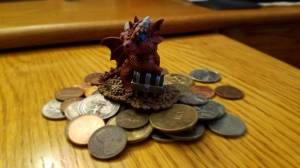(You may be wondering where the second part of the Dragon’s Ring review is. Well, I got lazy and didn’t write it, so I shall conclude it here: the book is good. Not buy-in-hardcover good, but buy-in-paperback good. So there. Expect a review of the sequel, Dog and Dragon, somewhere down the line.)
So far this blog has mostly been about reviews, but part of my intention for it is to include some ruminations on writing. In part because I feel like it, and in part because I’ve spent the last two weeks reading biographies rather than fiction, we’re going to get rolling on that today. And in the nature of the blog, we’re going to be talking about writing dragons. Might as well make a series out of it while we’re at it. You certainly can’t cover the entire topic of writing dragons in one article.
For our first outing, we’re going to go over what I would argue should be the first question you should ask about your dragons you plan on creating: what can these these death reptiles do?
Savage or Savant?
If you’re a fan of Magic: The Gathering, then you know who Nicol Bolas is and just how twisty his mind is. We’re talking about a dragon whose schemes stretch across thousands of years and who knows how many planes. Whatever physical strength Bolas has is, frankly, irrelevant: it’s his mind that’s the true weapon.
On the other hand, we have the dragons of A Song of Ice and Fire (and yes, I do mean ASOIAF, because I haven’t seen Game of Thrones and still have hope that the novels will end better). The dragons of Westeros are pretty much just animals. Highly dangerous, and cunning by animal standards, but they’re not going to kill you with schemes. They’re going to kill you with fire.
When designing dragons for any sort of creative work, this is one of the earliest questions to ask yourself. This is less about your dragons’ sense of morality and more about their intellect, whether they’re a proper sapient race or if they’re closer to animals. Both have their place, but they fill very different niches within the world, ancient wisdom and cunning as opposed to instinctual savagery.
Speedy or Sturdy?
Let’s be honest with ourselves, folks. As awesome as Toothless is, he got himself shot down and crippled by a kid with a net gun. Night Furies aren’t the most durable of creatures, but they’re plenty fast enough to make up the difference. Contrast that with Smaug, a dragon so well-armored that he only has one weak spot on him. He’s not fast, but you can’t hurt him, so it works out.
That’s a decision you need to make regarding your own dragons: how do they fight? Through brute force, or agility? It may sound like a bit of a shallow question at this point, but the fact is that distinction will shape the entire behavior and culture of the species. Think of how humans show respect to those who defy or exceed what’s considered “normal” for our physical capabilities. That’s going to be the same for any other species.
Mundane or Mage?
The third question we ask ourselves is, what sort of magical potential do these dragons have? And this is being determined against the baseline of what a dragon is; we’re not including the ability to breathe fire or fly in this category (unless your setting requires it to be so, I guess).
This one is tricky, because a dragon is already a pretty powerful creature, and giving them magic on top makes them even more powerful. As with all other magic systems, care must be taken, and what you let your dragons do should fit within the purpose those dragons have within your story.
The Real Question
You might have noticed a common theme in the above discussions, and a common question: what purpose do the dragons in your setting serve? That’s the real question that you have to answer, the one that informs everything else. You can’t just drop some dragons into your setting and expect it to work: they have to have a place within the world. They have to serve some purpose to the story beyond just looking awesome.
Once you figure that it, getting everything else to fall into place is far simpler.

